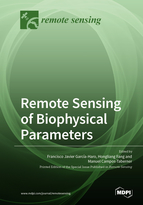Remote Sensing of Biophysical Parameters
A special issue of Remote Sensing (ISSN 2072-4292).
Deadline for manuscript submissions: closed (30 November 2020) | Viewed by 72151
Special Issue Editors
Interests: biophysical parameters estimation; canopy reflectance models; spectral mixture analysis; classification; data fusion; validation
Special Issues, Collections and Topics in MDPI journals
Interests: optical remote sensing; biophysical parameter estimation; vegetation; radiative transfer modeling; calibration/validation; in situ measurements
Special Issues, Collections and Topics in MDPI journals
Interests: biophysical parameter retrieval; machine learning; radiative transfer modelling; calibration/validation; classification; in situ measurements
Special Issue Information
Dear Colleagues,
Vegetation plays an essential role in the study of the environment through plant respiration and photosynthesis. Therefore, the assessment of the current vegetation status is critical to modeling terrestrial ecosystems and energy cycles. Canopy structure (LAI, fCover, plant height, biomass, leaf angle distribution) and biochemical parameters (leaf pigmentation and water content) have been employed to assess vegetation status and its dynamics at scales ranging from kilometric to decametric spatial resolutions thanks to methods based on remote sensing (RS) data.
Optical RS retrieval methods are based on radiative transfer processes of sunlight in vegetation, determining the amount of radiation measured by passive sensors in the visible and infrared channels. The increased availability of active RS (radar and LiDAR) data has fostered their use in many applications for analysis of land surface properties and processes, thanks also to their insensitivity to weather conditions and the capability to exploit rich structural and texture information. Optical and radar data fusion and multi-sensor integration approaches are pressing topics to fully exploit the information conveyed by both optical and microwave parts of the electromagnetic spectrum.
This Special Issue will review the state of the art in biophysical parameters retrieval and its usage in a wide variety of applications (e.g., ecology, carbon cycle, agriculture, forestry and food security). Articles covering recent research about the following topics are invited for this Special Issue:
- Field methods to measure vegetation biophysical parameters.
- Methods for the retrieval of canopy (e.g., LAI, fCover, fAPAR, plant height, biomass)and leaf biochemical (e.g., leaf chlorophyll/water and fuel moisture contents), as well as fuel/vegetation water content parameters from satellite and airborne sensors.
- Construction and improvement of radiative transfer models, and input data needed for the retrieval of vegetation parameters.
- Evaluations of recent missions (e.g., Sentinel-1, -2, and -3) to improve the spatial and temporal resolutions of retrieved biophysical maps.
- LiDAR and microwave Remote Sensing.
- Vegetation parameter retrieval from Unmanned Autonomous Vehicle (UAV) and high-resolution data.
- Processing of big remote sensing data, e.g., data fusion and multi-sensor data integration techniques
- Development of operational biophysical products and services using remote sensing.
- Calibration/validation activities for biophysical parameter products.
- Methods to estimate vegetation status and condition (e.g., vegetation diseases, stress condition, forest disturbance, degradation and regrowth).
- Assimilation of biophysical parameters derived from remote sensing for agriculture and forestry applications.
Review articles covering one or more of these topics
Prof. Francisco Javier García-Haro
Prof. Dr. Hongliang Fang
Dr. Manuel Campos-Taberner
Guest Editors
Manuscript Submission Information
Manuscripts should be submitted online at www.mdpi.com by registering and logging in to this website. Once you are registered, click here to go to the submission form. Manuscripts can be submitted until the deadline. All submissions that pass pre-check are peer-reviewed. Accepted papers will be published continuously in the journal (as soon as accepted) and will be listed together on the special issue website. Research articles, review articles as well as short communications are invited. For planned papers, a title and short abstract (about 100 words) can be sent to the Editorial Office for announcement on this website.
Submitted manuscripts should not have been published previously, nor be under consideration for publication elsewhere (except conference proceedings papers). All manuscripts are thoroughly refereed through a single-blind peer-review process. A guide for authors and other relevant information for submission of manuscripts is available on the Instructions for Authors page. Remote Sensing is an international peer-reviewed open access semimonthly journal published by MDPI.
Please visit the Instructions for Authors page before submitting a manuscript. The Article Processing Charge (APC) for publication in this open access journal is 2700 CHF (Swiss Francs). Submitted papers should be well formatted and use good English. Authors may use MDPI's English editing service prior to publication or during author revisions.
Keywords
- Biophysical parameters estimation
- Radiative transfer modelling
- Optical and microwave
- Calibration/Validation








